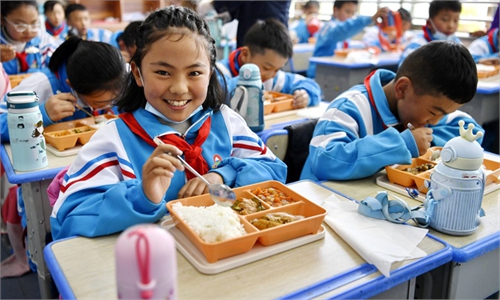Two border counties in SW China's Xizang upgraded into 'county-level city' to boost border development

This stitched aerial photo taken on December 18, 2022 shows the scenery of Mainling section of the Yarlung Zangbo River in the county-level city of Mainling in Southwest China's Xizang Autonomous Region. Photo: Xinhua
Two border areas of Mainling and Cona in Southwest China's Xizang (Tibet) Autonomous Region have been upgraded from "county" to "county-level city" to boost the economic development and society governance of border regions.
According to Xizang's regional government, Mainling and Cona will be placed under the direct jurisdiction of Xizang region with unchanged administrative areas after the approval of the Communist Party of China's Central Committee and the State Council.
The upgraded administrative ranking of the two border areas showed that China not only strives for a peaceful and harmonious border, but emphasizes to improve the governance in the border region so as to strengthen the border line, Qian Feng, director of the research department at the National Strategy Institute at Tsinghua University, told the Global Times on Wednesday.
Qian said unlike the counties that are under the direct management of city-level government which is under the provincial-level government, "county-level cities" are under the immediate jurisdiction of provincial-level government.
"The change of the status can improve social construction and development of border areas, make it more efficient for the administrative procedures, such as bottom-up program application and top-down policy implementation," said Qian
Located in southeastern Xizang, Mainling is a border county of Nyingchi City with a 180-kilometer-long border line and has rich forest and under-forest resources. According to Mailing's statistics department, Mainling has a population of about 26,176. Its GDP has reached nearly 2.1 billion yuan (roughly $300 million) in 2021 with the tertiary industry accounting for about 51 percent and the secondary industry covering about 40 percent.
Cona, also in southeastern Xizang, is home to around 16,068 local residents and is a very important border county in Shannan Prefecture neighboring Bhutan and India. In 2022, its GDP reached nearly 814 million yuan, 53 percent of which belonged to secondary industry and 44 percent was tertiary industry.
China started upgrading counties to "county-level cities" in the 1990s to match the country's rapid urbanization as the positioning of counties focused on agriculture while the latter stressed the development of industry and commerce, as well as service sector. Local economic development, population, urbanization, the level of public service and education, as well as the carrying capacity were usually taken into account to decide if the counties were qualified to be upgraded into "county-level cities."



